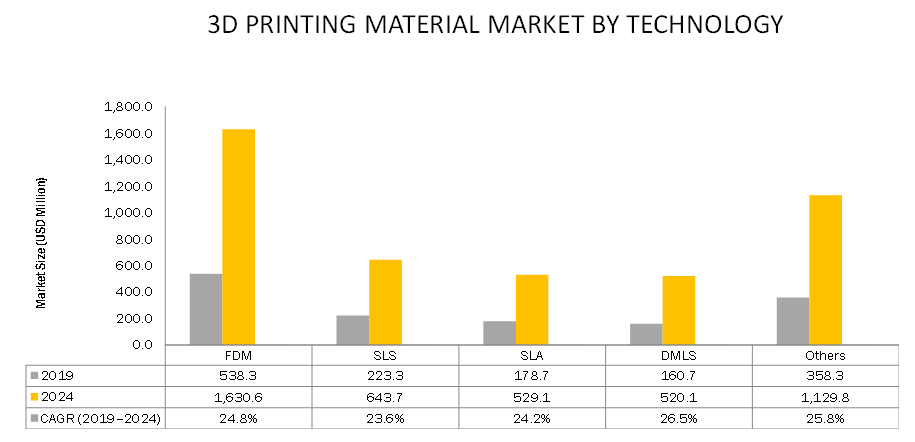Materials Science
Commercialization of 3D printing 21st May 2019
By Markets&Markets
3D printing is regarded as one of the major disruptive technologies that has transformed manufacturing processes across various in
3D printing is regarded as one of the major disruptive technologies that has transformed manufacturing processes across various industries, say the experts at Markets&Markets. But which materials represent the fastest growing segment of this market, and what does the future hold?

The term ‘3D printing’ covers a variety of processes in which material is joined or solidified under computer control to create a three-dimensional object. The precision, repeatability and material range of the process have driven its increasing adoption into industrial production technology, whereby the term ‘additive manufacturing’ is used synonymously with 3D printing.
Creating complex geometries and customized products is now more simplified due to the 3D printing process, and various types of materials can be used to create these objects. 3D printing materials can be broadly classified into four types: plastics, metals, ceramics and ‘others’ (e.g. wax, bio-inks, laywood, edible materials). These materials are used in the form of filament, powder or liquid. According to a new MarketsandMarkets report released this month (May 2019),1 the total market for 3D printing materials is projected to grow from $1.5 billion in 2019 to $4.5 billion by 2024, at a CAGR of 25%. The market is growing due to the high demand from the aerospace & defense, healthcare, and automotive industries.
The choice of material is based on the 3D printer used to print the objects. In terms of volume, plastics dominate the 3D printing materials market in which, photopolymer, PLA, and ABS are the main forms of plastics used. Plastics also offer the lowest cycle time with low operating temperatures, making them a suitable material type for 3D printing. However, the metals segment is the fastest-growing 3D printing material owing to the growing usage of 3D printing for the mass manufacturing of components in the automotive and aerospace and defense industries.
The automotive industry is witnessing a shift toward 3D-printed components owing to their benefits such as weight reduction and improved mileage in vehicles. Some of the European and North American luxury car manufacturers have already adopted 3D printing technology for the mainstream production of certain components of automobiles due to its suitability in making lighter and more complex structures at optimized costs. For example, in the first quarter of 2018, the leading car manufacturer, Bugatti (France), revealed a 3D-printed brake caliper made using titanium. In addition, BMW is collaborating with major 3D printing companies, including EOS (Electro Optical Systems, Germany) and Carbon (US) to manufacture 3D-printed parts for commercial vehicles.
Moreover, consumer 3D printing (mainly home 3D printers) is also contributed to the sudden rise in demand for 3D printing materials in recent years. Companies are offering 3D printers at low costs wherein anyone can purchase a printer and print their required objects or goods.
The fashion industry is also playing a major role in the growing use of 3D printing materials in consumer goods. For instance, the leading shoe manufacturer, Adidas (Germany) entered into a partnership with one of the major manufacturers of 3D printing materials, Carbon (US), where the former company will leverage Carbon’s Digital Light Synthesis technology to produce a new 3D-printed shoe, namely Futurecraft 4D.

There are various technologies that are used to print 3D objects. Some of these technologies include fused deposition modeling (FDM), selective laser sintering (SLS), stereolithography (SLA), direct metal laser sintering (DMLS), polyjet and binder jetting, among others. These additive manufacturing technologies are used to create visual models, prototypes and production parts using various materials such as plastics, metals, and ceramics. They help in creating objects with exceptional detail, high accuracy, and excellent mechanical properties. These technologies are chosen as per the form and type of material. For instance, DMLS technology is a powder bed fusion technology that is used to print 3D objects using metal powders. FDM is the most widely used technology across the world due to its inexpensive nature and excellent compatibility with plastic materials.
Additionally, various other 3D printing technologies are being used in additive manufacturing, including binder jetting, multi-jet fusion (MJF), material jetting, polyjet, and electron beam melting (EBM). Among these technologies, polyjet is one of the major technologies available in the 3D printing market, as it can create objects with multiple materials simultaneously. Various companies are working on the advancement of 3D printing technology to improve the efficiency of the materials to print objects. For instance, the US-based company, Carbon, introduced Digital Light Synthesis technology that uses digital light projection, programmable liquid resins, and oxygen permeable optics for manufacturing parts with superior mechanical properties, surface finish, and resolution.
In addition, in the 3D printing materials market, manufacturers are highly inclined toward inorganic growth strategies that lead to the increasing penetration of 3D printing in mass manufacturing. They are also investing heavily in R&D to introduce new products in the market that are suitable for applications in the automotive, healthcare, and aerospace and defense industries. All these factors are expected to accelerate the growth of 3D printing. Furthermore, the recent advancements in bio-printing that enable the printing of human organs using the 3D printing technology are expected to contribute to the growth of the 3D printing materials market in the healthcare industry.
Reference
1. Markets&Markets. 3D Printing Materials Market, May 2019. (https://www.marketsandmarkets.com/Market-Reports/3d-printing-materials-market-1295.html)
Contact
MarketsandMarkets provides quantified B2B research on 30,000 high growth emerging opportunities/threats which will impact 70% to 80% of worldwide companies’ revenues. Almost 75,000 top officers across eight industries worldwide approach MarketsandMarkets for their painpoints around revenues decisions.



